BRITISH EGGCASE ID GUIDE





The Great Eggcase Hunt is based on four main themes:
The Great Eggcase Hunt guide follows the same structure. Each section covers in-depth what you need to do to take part in the Great Eggcase Hunt, covering eggcase form, where best to find eggcases and how to report them to the Great Eggcase Hunt.
Download the full 'Great Eggcase Hunt Training Guide' now! (see right)
EGGCASE CHAMPION TRAINING GUIDE


This guide is designed as part of the 'Identify' section, focussing specifically on eggcaes found around the British Isles.
While this guide will focus on 13 eggcases from the British Isles, it is worth noting that many of these eggcases can also be found in North Western Europe, and even in the Mediterranean!
While we do have an ID guide for this region, this guide will go thorough each of the 13 eggcases commonly found around the British Isles, detailing the key features and how to identify each eggcase.
For eggcases found in other regions, please see our range of regional and/ or translated identifcation resources by scanning the QR code.

British Isles and Northwest Europe (English | Cymraeg)

There are five key groups (or Orders) of Chondricthyans that lay eggs: catsharks, skates, chimaera, horn sharks and carpet sharks. The eggcases from each Order have specific traits that can help you work out which group it comes from.
In the British Isles, we don't get horn sharks or carpet sharks. Although we do have some species of chimaera in our waters, we haven't yet had a beach find from the British Isles. As such, this guide will only cover the 13 most common catshark or skate species in our waters.
The key features for skate and catshark eggcases are:
Elongated and almost oblong in shape, often with long curly tendrils attached to each corner.

FEATURES - Does the eggcase have horns, tendrils, aprons or keels? How thick are the margins of the eggcase?
SIZE - How big is the eggcase capsule? Are the horns long or short? Are the horns thin and delicate or short and stocky?
SHAPE - What Order does the eggcase come from? Does the capsule taper? Does it have a distinctive pinch?
Rectangular or almost square with a dinstinctive horn at each corner, although this can be masked by keels or aprons on some eggcases.

Soaking your eggcases in water will help them rehydrate, getting them closer to their usual size and making key features easier to spot!
NOTE
Although there are other egglaying species in the region, they tend to be deeper water and so their eggcases are less likley to wash ashore.

Once you’ve found your eggcase(s), it’s time to identify your finds!
For guidance on how to differentiate between the 13 species found around the British Isles watch the video below.
Alternatively, the following pages run through each of the eggcases including key features for each.

In the UK there are three species of catshark that are likely to washup, although two of these eggcases are much more likley to wash ashore than the third...
A common feature of catshark eggcases is the curly tendrils extending from the top and bottom of the eggcase. These are used to anchor the eggcase to seaweed.





Blackmouth Catshark eggcases are rarely encountered (in fact we only have five verified eggcases recorded to the Great Eggcase Hunt from the British Isles). This deepwater shark can lay 60-100 eggs a year.
HOW TO IDENTIFY:
• Very small elongated eggcase
• Short horns that curve inwards, leaving almost no gap between the lower horns
• No tendrils





SIMILAR TO:
Smallspotted Catshark eggcase, but has short, curved horns instead of tendrils.

Scyliorhinus canicula
The Smallspotted Catshark (or Lesser Spotted Dogfish) is the most commonly found shark eggcase, and can be found on all coasts of the British Isles. This coastal shark is often encountered by divers.
The eggcases from this species can really vary in colour – from golden/yellow through to black.
HOW TO IDENTIFY:
• Small elongated eggcase
• Fine curly tendrils



SIMILAR TO:
Nursehound eggcase but is much smaller and less robust.
Blackmouth Catshark eggcase, but has tendrils instead of horns.
Scyliorhinus stellaris
The Nursehound (or Bull Huss) is the largest of the catshark eggcases found in the British Isles. This coastal shark is common in British waters and they like rocky areas with lots of algae cover.
This species is largely found in the south and southwest, and around the coast of Wales where on some beaches, it can be found in their hundreds.
HOW TO IDENTIFY:
• Large elongated eggcase
• Thick, robust margins and thick, curled tendrils
• Tough and robust capusle



SIMILAR TO:
Smallspotted Catshark eggcase, but is much bigger and more robust.


In the UK there are 10 species of skate that are likely to wash up. We will split these eggcaes into three sections: the large skate, small keeled skate and small non-keeled skate.
PLEASE NOTE:
Despite truly being skate, many species are referred to as rays in their common names!

A selection of eggcases found in Co. Cork, Ireland © Christine Thery | GEH
First off, it’s best to distinguish by size. There are only a few eggcases that are greater than 13 cm (and this is just the capsule, not including the horns).
In the British Isles there are three large skate eggcases:





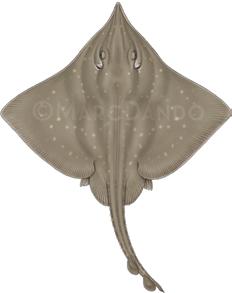


This species along with the Flapper Skate were once thought to be the same species, the Common Skate. In 2010 they were finally recognised as being distinct species. This Critically Endangered skate can be found in the Irish Sea & waters of Northwest Scotland, but it’s eggcases are rarely recorded to the Great Eggcase Hunt (we’ve only had 14 reported as beach finds!).
HOW TO IDENTIFY:
• Short horns curve inwards
• Keels are present but very small
• Aprons at top and bottom
• Capsule surface has a golden barklike layer
SIMILAR TO:
Flapper Skate but slightly smaller.



RARE FIND
This skate is mostly found in Ireland and the Celtic Sea, though we’ve had them reported from Devon, Cornwall, North Wales and Scotland. This species lays 55-156 eggs a year!
HOW TO IDENTIFY:
• Square in shape with textured, honeycomblike surface
• Keels & aprons present
• Long, ribbon-like upper horns
• Short & hooked lower horns
SIMILAR TO:
Flapper Skate in size, but the eggcases look very different!




This species is predominantly found in northern and western coasts of Scotland and the northern isles –particularly Orkney.
This Critically Endangered skate breeds every other year laying up to 40 eggcases during the summer.
HOW TO IDENTIFY:
• Very large eggcase
• Horns encompassed by the keels and aprons
• Keels and aprons present
• Capsule surface has a golden bark-like layer
• Older capsules will be darker and won’t rehydrate so well.
SIMILAR TO:
Blue Skate but slightly bigger.




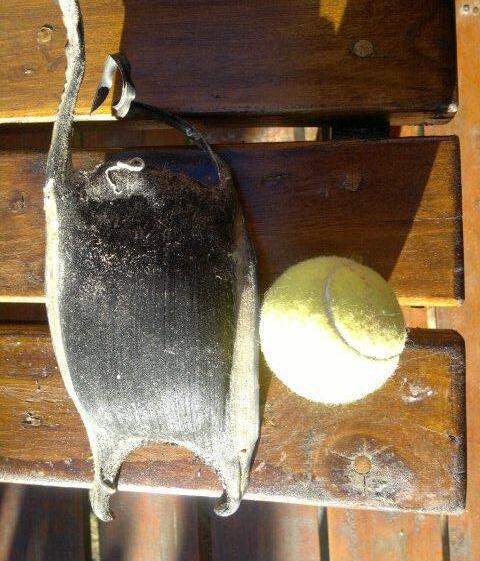


Next we'll look at the smaller skate, those under 13 cm (not including the horns).
After size, the next thing to look at is whether they have keels. That’s the flattened bit along the longer edges of the capsule.
In the British Isles there are four skate species that have eggcases under 13cm with keels:


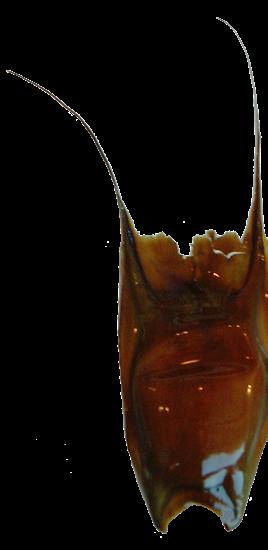



This is the smallest skate eggcase, and is usually found on North Sea coasts. This eggcase is one of the rarer ones to wash ashore.
This skate lays 10-41 eggcases on sand or mud every year.
HOW TO IDENTIFY:
• Keels & aprons present
• Upper & lower horns similar length
• Capsule has wash-board like textured surface




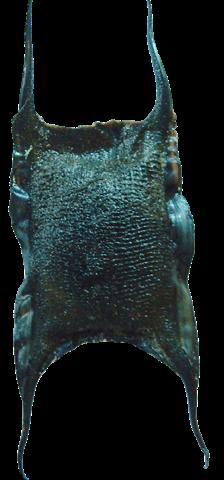

Raja clavata
The most common skate eggcase found around the British Isles. This eggcase can be found on all British coasts.
This skate lays 140-160 eggs a year in spring/ summer.
HOW TO IDENTIFY:
• Medium sized, square or rectangular in shape
• Keels & aprons present
• Short, stocky horns. Upper horns slightly longer than bottom
• Distinct pinch under the upper horns

SIMILAR TO:


Blonde Ray but smaller, with much shorter horns.
This skate is mostly found around the southern and southwestern coasts of the British Isles. This skate breeds in summer, laying 54-61 eggs a year.
HOW TO IDENTIFY:
• Very long, delicate upper horns that can brake off easily
• Lower horns are short & hooked
• Keels & aprons present. Keels are very fine
• Eggcase tapers from top to bottom



SIMILAR TO:
Thornback Ray, but the upper and lower horns differ

Raja brachyura
This is one of the larger, commonly found eggcases around the UK coast, found on the southern and western coasts of the British coastline.
This skate lays around 30 eggs a year between February and August.
HOW TO IDENTIFY:
• Larger eggcase
• Long upper horns
• Keels & aprons present
• Distinct pinch under the upper horns
SIMILAR TO:
Thornback Ray but bigger with longer upper horns






© User QIUb4ck9udgDa4eK82de1Kw6Uzn1


Finally, we'll look at the last of the smaller skate, those under 13 cm (not including the horns).
Now that we have addressed the eggcases with keels, it is time to look at those without keels.
In the British Isles there are three skate species that have eggcases under 13cm without keels:
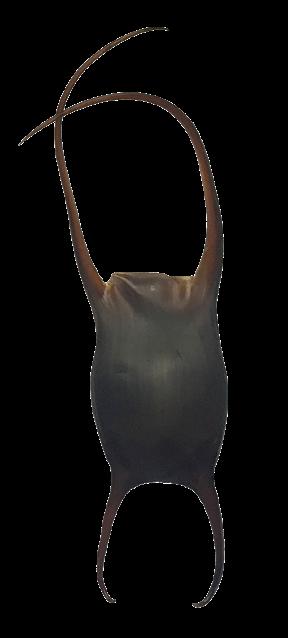
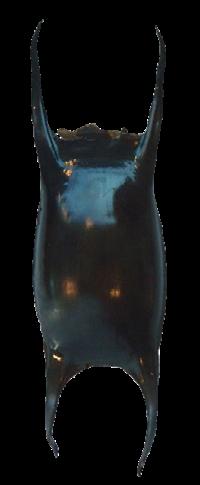


The Cuckoo Ray has these beautiful upper horns which are long and curve inwards, however they’re very fragile so can break very easily!
This skate reproduces all year round, laying 70150 eggs a year.
HOW TO IDENTIFY:
• No keels. Capsule edges are very neat and rounded
• Aprons present but might not be obvious
• Very long, delicate upper horns
• Eggcase looks almost sleigh-like when viewed from the side

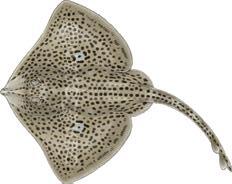



SIMILAR TO:
Spotted Ray but the upper horns are much longer. Can be hard to tell apart if the horns have snapped off!

Raja montagui

The Spotted Ray is one of the more commonly found eggcases which has a wide-ranging distribution and can be found on all British coasts.
It’s a very neat capsule, and can be quite small, particularly if dried out.
HOW TO IDENTIFY:
• Upper horns slightly longer than lower horns
• No keels, neat capsule edges.
• Aprons present


SIMILAR TO:
Undulate Ray but smaller and typically neater too!
Undulate Ray eggcases look very similar to the Spotted but they are a bit larger and more ragged in appearance. Undulate Ray eggcases will often have attachment fibres on the side.
This species is more limited in range and generally found on the south coast of the UK, southwestern Ireland, and in the Channel Islands
HOW TO IDENTIFY:
• Top horns often splay outwards
• No keels. Capsule edges can be ragged, often with attachment fibres
• Aprons
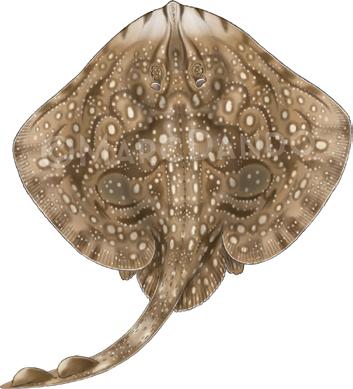

SIMILAR TO:

Spotted Ray, but larger and more ragged in appearance

The range of sizes indicated on the ID guides are approximate so you may find some species that are smaller or larger than stated.
Older eggcases won’t rehydrate so well so may still be a bit warped and not expand to their original size, which can make some of the key features harder to spot.
Eggcase horns & tendrils are delicate and may break off by the time you find the eggcase washed up on the beach.
Sometimes it’s obvious that a horn is missing, but sometimes it can be misleading. For example, darker Smallspotted Catshark eggcases without their tendrils can easily be mistaken for Blackmouth Catshark eggcases!
Just to confuse things... not only do Spotted Ray eggcases and Undulate Ray eggcases look very similar, but there is a cross over of range and sizes too!
This means that they can be really challenging to tell apart – especially if you get a larger Spotted and a smaller Undulate. These ones we endearingly refer to as Spundulates.
Try not to use colour as an indicator as this varies greatly. Fresh skate eggcases can have a green tinge to them, but become a dark brown or black over time! Catshark eggcases can vary greatly, ranging from amber, to brown, to dark green, to black!
If you are really stuck with the ID you can always submit a photo with the species listed as 'unknown' & one of our eggcase experts willl ID it for you! Alternatively, email us at eggcase@sharktrust.org


© Sarah Hannis | GEH
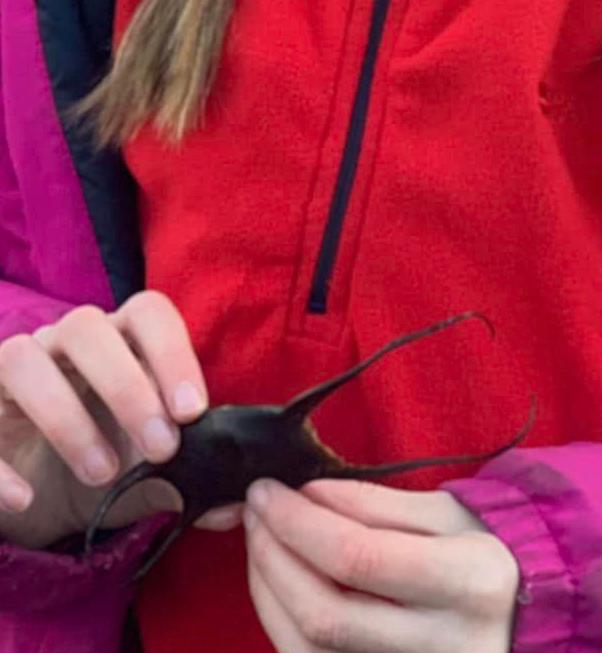

You’re now well and truly part of the eggcase family and on your way to becoming an Eggcase Champion! Whether you’ve submitted one eggcase or a hundred, this project wouldn’t be possible without you and we’re so grateful that you’ve decided to take part.
